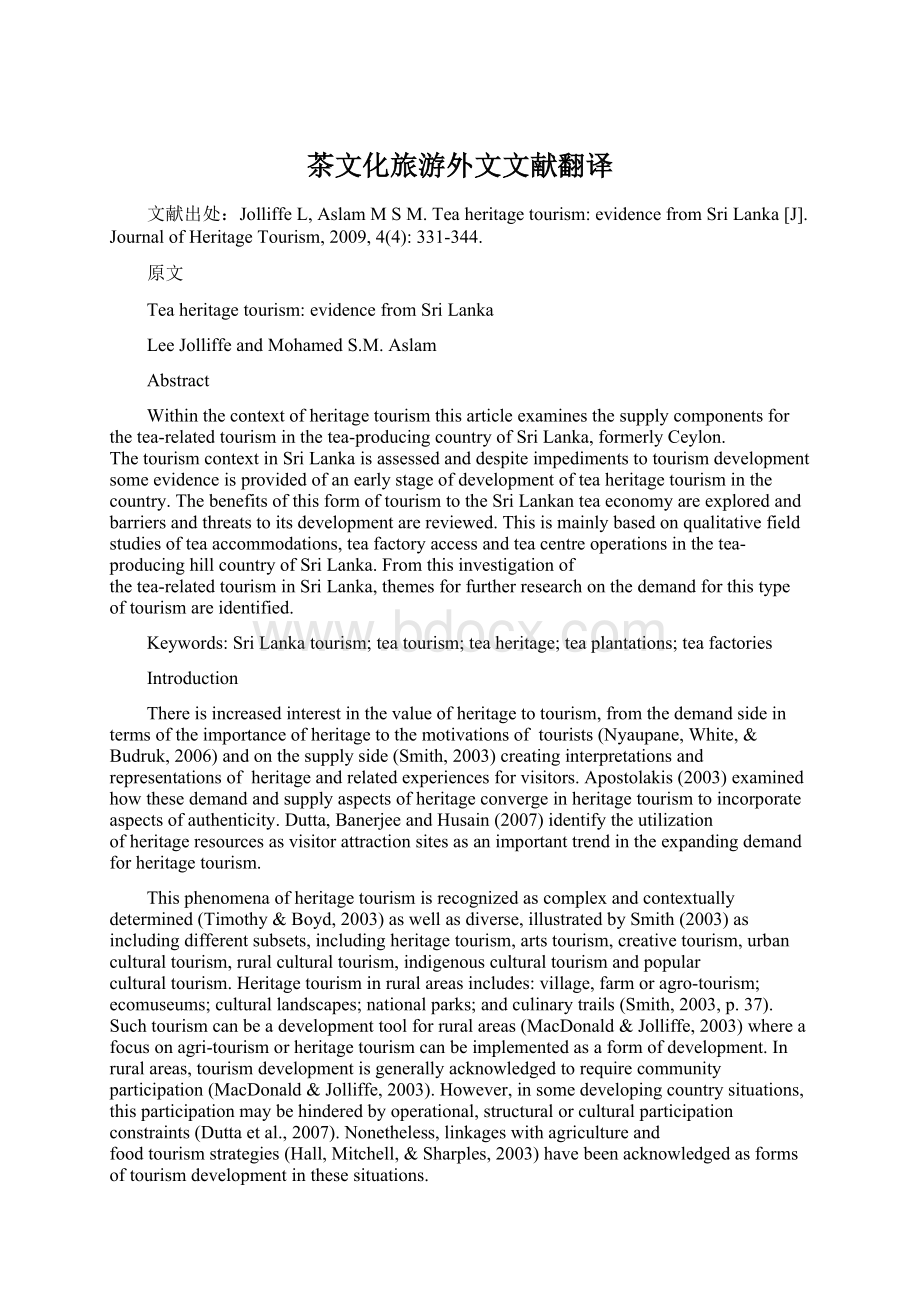茶文化旅游外文文献翻译.docx
《茶文化旅游外文文献翻译.docx》由会员分享,可在线阅读,更多相关《茶文化旅游外文文献翻译.docx(7页珍藏版)》请在冰豆网上搜索。

茶文化旅游外文文献翻译
文献出处:
JolliffeL,AslamMSM.Teaheritagetourism:
evidencefromSriLanka[J].JournalofHeritageTourism,2009,4(4):
331-344.
原文
Teaheritagetourism:
evidence fromSri Lanka
LeeJolliffeandMohamedS.M.Aslam
Abstract
Withinthecontextof heritage tourism thisarticleexaminesthesupplycomponentsforthe tea-related tourism inthe tea-producingcountryof Sri Lanka,formerlyCeylon.The tourism contextin Sri Lanka isassessedanddespiteimpedimentstotourism developmentsome evidence isprovidedofanearlystageofdevelopmentoftea heritage tourism inthecountry.Thebenefitsofthisformof tourism tothe SriLankan tea economyareexploredandbarriersandthreatstoitsdevelopmentarereviewed.Thisismainlybasedonqualitativefieldstudiesof tea accommodations,tea factoryaccessand tea centreoperationsinthe tea-producinghillcountryof SriLanka.Fromthisinvestigationofthe tea-related tourism in Sri Lanka,themesforfurtherresearchonthedemandforthistypeof tourism areidentified.
Keywords:
SriLankatourism;teatourism;teaheritage;teaplantations;teafactories
Introduction
Thereisincreasedinterestinthevalueof heritage to tourism,fromthedemandsideintermsoftheimportanceof heritage tothemotivationsof tourists (Nyaupane,White,&Budruk, 2006)andonthesupplyside(Smith, 2003)creatinginterpretationsandrepresentationsof heritage andrelatedexperiencesforvisitors.Apostolakis (2003) examinedhowthesedemandandsupplyaspectsofheritage convergein heritage tourism toincorporateaspectsofauthenticity.Dutta,BanerjeeandHusain (2007) identifytheutilizationof heritage resourcesasvisitorattractionsitesasanimportanttrendintheexpandingdemandfor heritage tourism.
Thisphenomenaof heritage tourism isrecognizedascomplexandcontextuallydetermined(Timothy&Boyd, 2003)aswellasdiverse,illustratedbySmith (2003) asincludingdifferentsubsets,includingheritage tourism,arts tourism,creative tourism,urbancultural tourism,ruralcultural tourism,indigenouscultural tourism andpopularcultural tourism. Heritage tourism inruralareasincludes:
village,farmoragro-tourism;ecomuseums;culturallandscapes;nationalparks;andculinarytrails(Smith, 2003,p.37).Such tourism canbeadevelopmenttoolforruralareas(MacDonald&Jolliffe, 2003)whereafocusonagri-tourism or heritage tourism canbeimplementedasaformofdevelopment.Inruralareas, tourism developmentisgenerallyacknowledgedtorequirecommunityparticipation(MacDonald&Jolliffe, 2003).However,insomedevelopingcountrysituations,thisparticipationmaybehinderedbyoperational,structuralorculturalparticipationconstraints(Duttaetal., 2007).Nonetheless,linkageswithagricultureandfood tourism strategies(Hall,Mitchell,&Sharples, 2003)havebeenacknowledgedasformsof tourism developmentinthesesituations.
Tourism in Sri Lanka
Sri Lanka,formerlyCeylon,isasmallisland(65,610squaremiles)intheIndianOceanoffthesoutheasterncoastofIndia,880 kmnorthoftheequator.Occupyingastrategicpositioninancientsearoutesforcenturiestravellershavebeenattractedtothenaturalandculturalresourcesofthistropicalisland.Thecountryexperiencesavarietyofclimatesandweatherconditionsthroughouttheyearwith14–27°CtemperaturesfromthehillcountrytolowlandsandsouthwestmonsoonandnortheastmonsoonrainsfromMaytoJulyandDecembertoJanuaryrespectively(EncyclopediaBritannica, 2004).Therehavebeenanumberofthreatstothegrowthof tourism in Sri Lanka,notablyfromrecurringcivilconflictandthe2004Asiantsunami.Formanyyears tourism thushasnotbeenabletoflourish(SriLanka Tourism DevelopmentAuthority, 2007).Cochraneindicates‘nootherdestinationhasbeenbesetbysucharangeoflong-lastingandseriouscrisesas Sri Lanka’.Inaddition,contemporary tourismdevelopmentissuesfor Sri Lanka includeconservationandpreservation,diversificationanddiversion,benefitsandcosts,constructionanddestruction,aswellasforwardandbackwardlinkages,as tourismlinkagesarepervasivewithintherelativelydiversifiedeconomy(Cochrane, 2008,p.79).
Althoughrecognizedasatoolofsocio-economicdevelopment, tourism herecouldnoteffectivelycontributetosustainabledevelopmentduetopoorpolicyplanningandmismanagement(Aslam, 2004;Bandara, 2003)particularlywithinagriculture.Aftertheestablishmentofthe Tourism MasterPlanin1992(UnitedNationsDevelopmentProgramme(UNDP)&WorldTradeOrganization, 1993)thepoliciesandbehaviouroftheindustrystartedtomovetowardssustainabledevelopment,whichstimulatesandimprovesthelivingstandardsofthepeople,whilepreservingandconservingthenaturalfragileandmanmaderesources.Economic-orientedpolicyandbehaviourofdestinationsorhostsledtheindustry